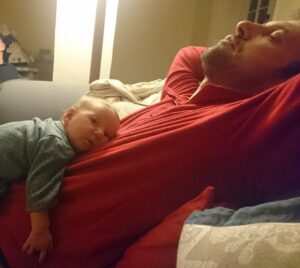We’d always wanted a third child, but we weren’t sure whether my wife, Laura, could cope with another pregnancy. She’d had PGP in both previous pregnancies. In the last trimester, she was barely able to walk, sit for any period of time or get any comfortable sleep. And now we had two small children to look after.
So here we were, mapping out a timeline in Excel, working out when I could take time off work and when our respective mothers could come to stay and help over what might be 3-4 months of incapacity.
When Laura got pregnant with our first child, she had been determined to stay fit. She still walked 45 minutes to work, signed up for pregnancy fitness classes and did yoga most nights. But around 14 weeks, she started to slow down. Normally miles ahead and telling me to hurry up, she was the one lagging behind, struggling to walk without pain.

In the second and third pregnancies, we obviously had kids to deal with – I’d do most of the carrying and made sure to pick up shopping and bags. I was also worried about the kids seeing their mum in pain and not having the access to her that they should at such a young age. That meant I tried to make it easier for them to be with her when she was sitting or lying, like playing with them next to her, or sitting beside her on the sofa so we could read together, but I could stop them jumping on her.
Work got really hard for her in the second pregnancy. This was pre COVID and no one really worked at home. She was finding it increasingly difficult to walk from the train station to the office. We even talked about her driving into work, but the city centre parking was incredibly expensive, so in the end we had to reduce her hours at work and taper off her days well before the due date. So that meant we had to think carefully about our finances – but ultimately her health was more important.
By the time we were considering a third child, I was more comfortable with the fact that she’d recovered twice before. I knew there was a high chance that she’d go through all this pain again though, so we thought very hard about whether to even try.

With advice from the Pelvic Partnership, Laura asked for a referral to the women’s health physio at her first midwife appointment. She felt much more confident in describing her symptoms and how PGP had affected her before but she still had to push quite hard to get the referral. She did, however, get to see a physio fairly early on . The physio wasn’t that familiar with PGP but was really willing to learn. Laura gave her the Pelvic Partnership leaflets and she gave Laura manual therapy which relieved her symptoms and massively improved her mental health.
It’s very hard to see your partner in pain. My tips would be:
Knowing that there was specialist support available for Laura would have been helpful at the start – we found it in the end but I wish I’d known about it earlier. Treatment is available but not always easy to get, so be an advocate for your partner and support her to ask for the help she needs to recover.
Donate today to help us help others with pregnancy-related pelvic girdle pain (PGP)
Donate now